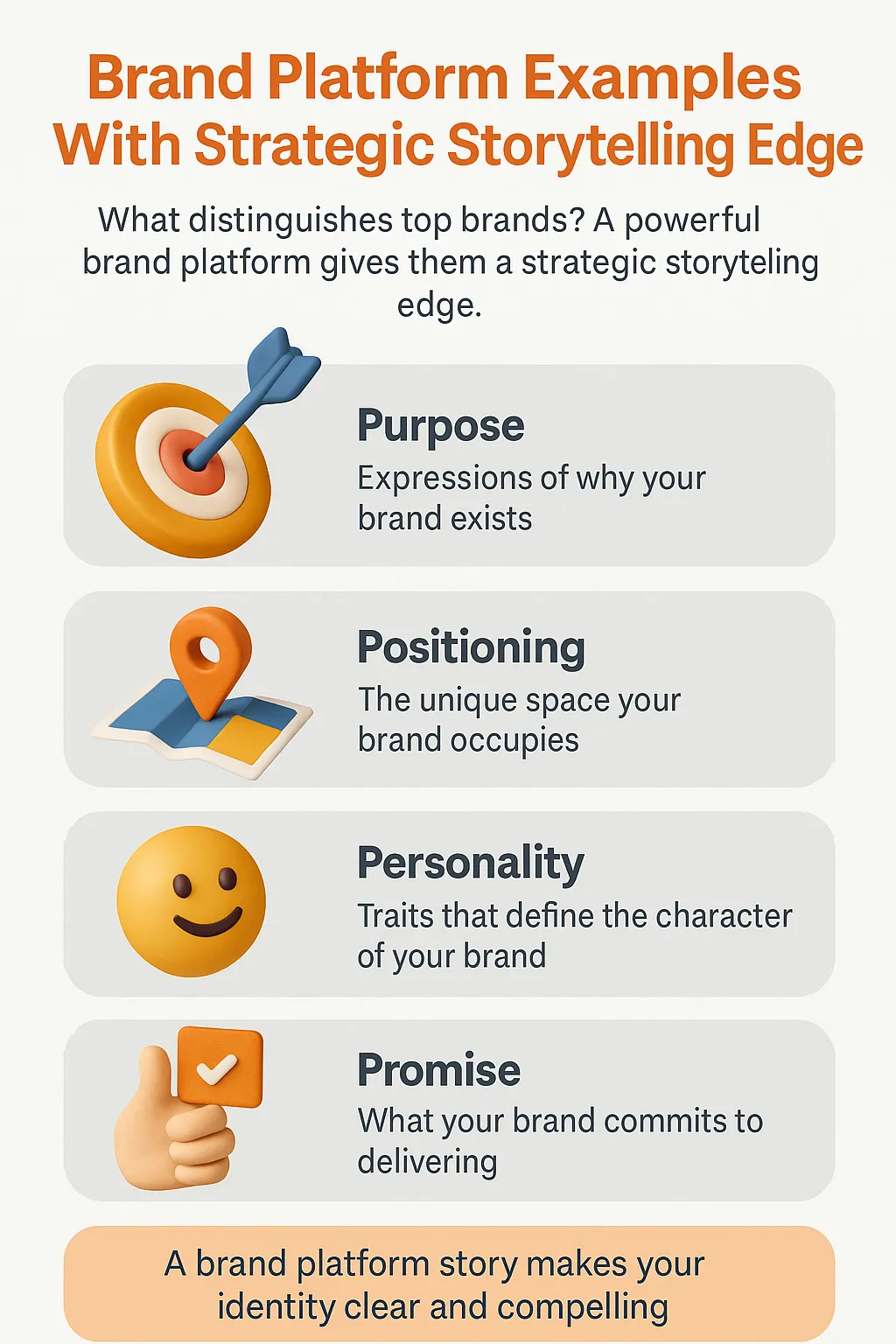Ever wonder what makes a brand unforgettable? The answer often lies not in the logo or colors—but in the brand’s core story. Through our work with founders, marketing teams, and creative leaders, we've seen how a strategic brand platform serves as the narrative engine that powers visual identity, messaging, and emotional resonance. In this guide, we’ll unpack real-world brand platform examples that showcase how storytelling elevates brand identity and fuels long-term connection with audiences.
Top Takeaways
- A well-crafted brand platform is the launchpad for impactful storytelling.
- Brands like Airbnb, Glossier, and Oatly prove that when story meets strategy, the result is unforgettable design.
- Clear brand narratives build consistency, customer trust, and visual cohesion.
- A compelling identity doesn’t start with artboards—it begins with meaning.
Understanding the Power of a Brand Platform
A brand platform is more than a polished elevator pitch—it’s the backbone of a brand’s identity. It sets the tone for storytelling, establishes voice, and defines how a company emotionally connects with its audience. When purpose, personality, and promise are aligned, the brand story comes alive visually and verbally—laying the foundation for powerful digital marketing that resonates across every channel.
These examples reveal that a strong brand platform isn’t hidden behind the scenes—it’s the story that’s told through every interaction, asset, and experience.
“In every project I’ve led, the creative breakthrough happened the moment we stopped decorating and started defining the story. Strategy drives storytelling. Storytelling shapes design—especially when guided by a marketing agency that knows how to align vision with execution.”
Case Study & Real-World Examples: Storytelling in Action
- Introduced the Bélo icon to represent connection, humanity, and place
- Inspired an inclusive design system grounded in people-first visualsOur Perspective:We’ve worked with travel and hospitality startups who’ve followed Airbnb’s example—anchoring their identity in emotion and designing from a clear core story.
- Clean, simple, and friendly aesthetics
- Relatable, transparent brand voiceOur Perspective:We’ve supported early-stage beauty brands in building similar customer-first platforms, using real feedback to shape visuals and tone with credibility and warmth.
- Disruptive, handwritten packaging style
- Messaging rooted in humor, activism, and transparencyOur Perspective:In branding projects with plant-based startups, we’ve referenced Oatly as a model for owning a unique voice—and letting it dictate bold visual storytelling.

Supporting Statistics: Storytelling That Drives Results
Consistent Narratives Fuel Growth
- Brands that consistently express their platform across all content and visuals report up to 33% higher revenue
- We’ve seen this reflected in rebrands where platform clarity improved performanceSource: Lucidpress via Marq
Clarity Multiplies Visibility
- Brands with a unified identity and message are 3–4x more likely to be highly visible in their market
- We've applied this in workshops, where unified voice and visual storytelling drove higher engagementSource: Marq Brand Consistency Report
Trust is Story-Driven
- 62% of consumers are more likely to pay more when they trust a brand’s values
- We’ve seen this especially in purpose-driven industries where story alignment builds loyaltySource: BBB Consumer Trust Report
Final Thought & Opinion: Let Story Shape Strategy
Over years of branding work, we’ve learned that the best identities don’t come from a mood board—they emerge from a story well told.
Why Story-First Strategy Wins
- Reveals why the brand exists
- Clarifies the audience and emotional connection
- Directs how the brand shows up in every medium
- Define your purpose
- Understand your audience’s emotional drivers
- Shape your platform as a story, not just a strategy
Your platform is your plot. Let design become the visual narration.
Next Steps: Apply Your Brand Story Strategically
Evaluate Your Current Brand Story
- Review your visuals, copy, and messaging
- Ask: Is there a clear story? A central message?
Craft or Refine Your Brand Platform
- Clarify your brand purpose, values, and personality
- Identify your core narrative themes
Design With Story in Mind
- Align visuals with voice and narrative tone
- Build design systems that reflect your story’s emotion
Educate Internally
- Share the story-driven platform with your team
- Train stakeholders to use it as a guide in all messaging
Launch, Measure, and Evolve
- Implement across all brand channels
- Gather feedback and iterate while staying true to your story
Frequently Asked Questions (FAQ)
What is a brand platform with a storytelling edge?
It’s a strategic framework that integrates purpose, personality, and audience with a clear, emotionally resonant brand story.
How does storytelling impact brand design?
Storytelling provides the emotional blueprint that informs design elements—from logo and color to typography and messaging tone.
Which brands use storytelling effectively in their platforms?
Top examples include Airbnb (Belonging Anywhere), Glossier (Skin First. Makeup Second.), and Oatly (bold voice + sustainability). Their stories drive design and messaging.
Can storytelling-based platforms work for small businesses?
Absolutely. Even solo brands can build strong platforms that use narrative to connect, differentiate, and scale with consistency.
How can I start building my own strategic brand story?
Begin by defining your brand’s “why,” identifying your audience’s needs, and shaping your values into a narrative that drives visuals and tone across all brand touchpoints.
In exploring Brand Platform Examples With Strategic Storytelling Edge, it becomes clear that strong brand narratives are built on clarity, consistency, and functional excellence—qualities that mirror high-performing product ecosystems as well. For instance, brands that prioritize environment and wellness can draw inspiration from tools like the 14x24x1 MERV 11 air filters that ensure clean air in commercial and residential spaces, while service providers focused on home performance benefit from resources such as HVAC Repair Broward County FL, which exemplifies reliability in action. Similarly, smart product positioning on platforms like Amazon’s 20x23x5 Pleated Replacement Furnace Filter, Walmart’s 14x20x2 MERV 13 Pleated HVAC AC Furnace Filters, and eBay’s trusted air filter options illustrate how brand platforms can align purpose with placement—amplifying credibility and storytelling through product trust. These examples emphasize that bold identity design doesn’t just look good—it communicates a deeper strategic narrative that customers can believe in.


